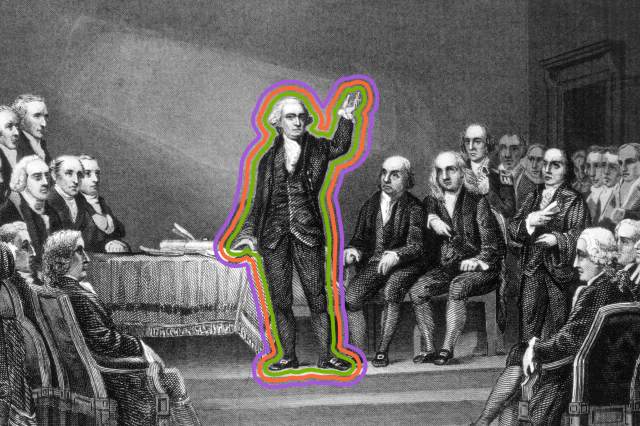
George Washington Began His Professional Career as a Surveyor
Not unlike other luminaries who embarked on one professional path before finding fame elsewhere, George Washington initially earned a living as a surveyor. He was appointed surveyor for Virginia’s Culpeper County in 1749, and later struck out on his own in the field for two years. By the time he joined the Virginia militia in 1752, Washington had undertaken nearly 200 surveys, encompassing more than 60,000 acres of land. He continued to utilize those skills for the rest of his life, usually in surveys involving his own extensive land holdings, and even conducted one final survey a few weeks before his death in late 1799.
George Washington Left Mainland North America Only Once
Washington’s only journey abroad took place in the second half of 1751, when he accompanied his tuberculosis-stricken half-brother Lawrence to Barbados. It was a life-changing trip in many ways for the impressionable 19-year-old, who was bowled over at the scale of the island’s densely populated and heavily fortified city of Bridgetown. Furthermore, thanks to family connections, he frequently broke bread with high-ranking British government officials and military officers, an experience that likely fueled his own ambitions. While Lawrence never recovered from his illness, Washington survived a health scare of his own by contracting smallpox. The exposure rendered him immune to the deadly disease when it swept through his Continental forces decades later.

George Washington Lost His First Bid for Public Office
Well before he agreed to serve the United States of America as its first President, Washington ran for a seat in the Virginia House of Burgesses in 1755 … and lost pretty badly. He tried again two years later, this time edging out the competition after resorting to the tried-and-true political method of buying drinks for his supporters. Washington wound up spending seven years in the House as a representative of Frederick County and another decade representing Fairfax County, before he abandoned the post in June 1775 to lead the Continental Army.
George Washington Surrendered to an Enemy in Battle Only Once
With both the British and French jostling for territorial rights in the fertile Ohio Valley, Lt. Col. Washington led a contingent of Virginia militiamen into modern-day Fayette County, Pennsylvania, in the spring of 1754. His first engagement with a smaller enemy force produced an easy victory, but it also sparked an angry French retribution — and the start of the French and Indian War. That July, after his outnumbered men were cornered in the poorly secured Fort Necessity, Washington signaled for surrender for the first and only time in his life. That allowed him and his men to return home in one piece, although Washington had to sign a document admitting he had “assassinated” a French commander as part of the arrangement.

He Had a Short Courtship With Martha Custis
Although he may have harbored a flame for his neighbor Sally Fairfax that never quite extinguished, Washington moved quickly to gain the good graces of the recently widowed and wealthy Martha Dandridge Custis in 1758. According to Ron Chernow’s acclaimed biography, they enjoyed their first arranged meeting in mid-March at her Virginia plantation home — coincidentally known as the White House — after which Washington sought to leave a good impression by heartily tipping the enslaved help. Within a few weeks, he had ordered new clothes from London and a gold ring from Philadelphia, and the speedy courtship culminated with their marriage at the White House in January 1759. Unfortunately, we don’t know more than the broad outlines of their early interactions, as Mrs. Washington burned all but a handful of their correspondence following his death.
The Revolutionary War General Lost More Battles Than He Won
Washington notched the less-than-inspiring record of six wins, seven losses, and four draws among his Revolutionary War battles. This was partly due to the superior training of British troops, but also because of the general’s deficiencies as a tactical commander. Modern critics contend that Washington favored unnecessarily complicated plans that relied on precision timing during nighttime and difficult weather conditions. On the other hand, Washington learned the value of a strategic retreat early enough in the Revolution, and he was smart enough to surround himself with capable aides. He also unquestionably galvanized his men with his bravery, as exemplified by his hands-on leadership less than 100 yards from the British front line during the Battle of Princeton in January 1777.
More Interesting Reads

He Could Really Get Down on the Dance Floor
Well-versed in the social customs of the colonial Virginia gentry, Washington developed a reputation for being a nimble and enthusiastic dancer. As a young officer, he was known to get the party started, so to speak, by being the first on the dance floor to perform the minuet. Later accounts tell of Washington letting loose during free moments of the Revolution, at one point dancing for more than three hours straight with the wife of General Nathaniel Greene. Even advancing age wasn’t enough to cramp his style, as the nearly 60-year-old President reportedly enjoyed staying up late to dance with locals during his 1791 Southern tour.
George Washington Did Not Have Wooden Teeth
Washington suffered from an array of tooth problems that necessitated dentures for much of his adult life, but his chompers weren’t made of wood, as popular lore sometimes suggests. Instead, his dentures were made of varying combinations of human and animal teeth, ivory, and metal. Sporting just one natural tooth by the time he was elected President in 1789, Washington wore a special set of dentures fashioned from ivory, brass, and gold for his inauguration. And while he could afford the best available dental care by that point, even the tailor-made fittings left the commander in chief complaining of pain and awkward bulging in his mouth.

His Second Inaugural Address Was Easily the Shortest of Any President’s
Taking the oath of office for the second time on March 4, 1793, President Washington delivered an inaugural address that comprised all of four sentences and 135 words. (By comparison, Franklin D. Roosevelt provided the second-shortest inaugural address, of 559 words, in 1945, while William Henry Harrison in 1841 unleashed the longest such address at 8,460 words.) It’s unclear why Washington elected to keep things so brief the second time around, although it may have reflected his Cabinet’s recommendation to make the ceremony more private, as well as his own ambivalence about serving the country again when he preferred to retire to his beloved Mount Vernon.
He Enjoyed the Company of Animals
Although it was hardly uncommon to see barnyard animals milling around an 18th-century plantation, Washington ran something closer to a zoo at his Mount Vernon estate. Along with the cattle, sheep, horses, hogs, and chickens on the grounds, Washington set aside an 18-acre parcel for tame deer, and dedicated himself to mule breeding. He also personally inspected his dog kennel twice a day, making sure to spend time with beloved canines that went by such outlandish names as Sweetlips and Madame Moose. Other animal inhabitants included his step-granddaughter’s green parrot and, for a limited time, a camel that made a Christmas 1787 appearance.












